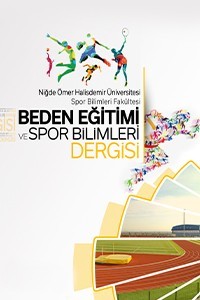YILDIZ MİLLİ VOLEYBOLCULARIN DÜŞEREK SIÇRAMADA YERLE TEMAS SÜRELERİ VE DÜŞME YÜKSEKLİĞİNİN GÜÇ VE İŞ ÇIKTILARINA ETKİLERİ
Rölatif maksimum güç, Rölatif iş, Kistler
THE EFFECT OF GROUND CONTACT TIME AND DROP HEIGHT ON WORK AND POWER OUTPUTS FOR DROP JUMP IN YOUTH TURKISH NATIONAL VOLLEYBALL PLAYERS
Relative maximum power, Relative work energy, Kistler,
___
- Atan, T., Taşmektepligil, M. Y., Ağaoğlu, S. A., Kabadayı, M., Bostancı, Ö., & İmamoğlu, O., “Drop Sıçramada Optimal Platform Selçuk Üniversitesi Beden Eğitimi ve Spor Bilim Dergisi. 13.2. pp.160–165. 2011. [In Turkish]. Belirlenmesi.”
- Ball, N. B., Stock, C. G., & Scurr, J. C., “Bilateral Contact Ground Reaction Forces and Contact Times during Plyometric Drop Jumping.” The Journal of Strength & Conditioning Research. 24.10. pp.2762– 2769. 2010.
- Behm, D. G., Wahl, M. J., Button, D. C., Power, K. E., & Anderson, K. G., “Relationship between Hockey Skating Speed Measures.” Journal of Strength and Conditioning Research. 19.2. pp.326. 2005. Performance
- Bobbert, M. F., “Drop Jumping as a Training Method for Jumping Ability.”Sports Med. 9.1. pp.7–22. 1990.
- Bobbert, M. F., Huijing, P. A., & Van Ingen Schenau, G. J., “Drop Jumping. II. The Influence of Dropping Height on the Biomechanics of Drop Jumping.”Medicine Science Sports Exercise. 19.4. pp.339– 346. 1987.
- Bobbert, M. F., Huijing, P. A., & van Ingen Schenau, G. J., “Drop Jumping. I. The Influence of Jumping Technique on the Biomechanics of Jumping.” Medicine and Science in Sports and Exercise. 19.4. pp.332–338. 1987.
- Clutch, D., Wilton, M., McGown, C., & Bryce, G. R.,“The Effect of Depth Jumps and Weight Training on Leg Strength and Vertical Jump.” Research Quarterly for Exercise and Sport. 54.1. pp. 5–10. 1983.
- Goss-Sampson, M., Alkureishi, R., & Price, M.,“Optimum Contact Time and the Amortization Phase in the Bounce Drop Jump.” PART I: BIOMECHANICS, Journal of Sports Sciences. 20.3-74. pp.8. 2002.
- Gulick, D. T., Fagnani, J., Long, M., Morris, K., Hartzell, B., & Epler, M., “Parameters That Influence Vertical Jump Height.” The Sport Journal. 11.3. 2008.
- Hoffren, M., Ishikawa, M., & Komi, P. V., “Age-Related Neuromuscular Function during Drop Jumps.” Journal of Applied Physiology. 103.4. pp.1276–1283. 2007.
- Kellis, E., Arabatzi, F., & Papadopoulos, C., “Muscle Co-Activation around the Knee in Drop Jumping Using the Co-Contraction Index.” Journal of Electromyography and Kinesiology. 13.3. pp.229–238. 2003.
- Peng, H. T., Kernozek, T. W., & Song, C. Y., “Quadricep and Hamstring Activation during Drop Jumps with Changes in Drop Height.” Physical Therapy in Sport. 12.3. pp.127–132. 2011.
- Ruan, M., & Li, L., “Approach Run
- Increases Preactivation and Eccentric Phases Muscle Activity during Drop Jumps from Different Drop Heights.” Journal of Electromyography and Kinesiology. 20.5. pp.932–938. 2010. 14. Self
- B. P., & Paine, D., “Ankle Biomechanics
- Techniques.” Medicine and Science in
- Sports and Exercise. 33.8. pp.1338–1344. 2001. Four Landing
- Walsh, M., Arampatzis, A., Schade, F., & Brüggemann, G. P.,“The Effect of Drop Jump Starting Height and Contact Time on Power, Work Performed, and Moment of Force.” The Journal of Strength & Conditioning Research. 18.3. pp.561–566. 2004.
- Yu, B., & Hay, J. G., “Angular Momentum
- and Performance in the Triple Jump: A Cross-Sectional Analysis.” Journal of Applied Biomechanics. 11.1. pp.81–102. 1995.
- ISSN: 1307-6477
- Yayın Aralığı: Yılda 3 Sayı
- Başlangıç: 2007
- Yayıncı: Niğde Ömer Halisdemir Üniversitesi
GÖRME ENGELLİ BİREYLERDE SPORUN DENGE VE YÜRÜME MESAFESİ ÜZERİNE ETKİSİ
Betül AKYOL, Nurettin KONAR, Meziyet TAŞÇI
Alparslan Gazi AYKIN, Fatma Pervin BİLİR
BAYAN VOLEYBOLCULARDA ESNEKLİK EGZERSİZLERİNİN DİKEY SIÇRAMA PERFORMANSI ÜZERİNE ETKİLERİ
Filiz Uğur BAYRAKTAR, Murat ÖZMADEN
14-16 YAŞ GRUBU ERKEK TENİSÇİLERDE TABATA PROTOKOLÜNÜN DİKEY SIÇRAMAYA ETKİSİ
Deniz DEMİRCİ, Bahar Odabaş ÖZGÜR, Turgay ÖZGÜR, Ebru BAYIR
ÜNİVERSİTELİ TRİATLETLERDE ALT EKSTREMİTE YAĞ ORANLARI YARIŞ ZAMANININ BELİRLEYİCİSİ MİDİR?
Ülviye BİLGİN, Ebru ÇETİN, Mergül ÇOLAK, İmdat YARIM, Halil TAŞKIN
KADINLARIN SPORU SEYRETME GÜDÜLERİNİN İNCELENMESİ
Hanifi ÜZÜM, Muhammet Cihat ÇİFTÇİ, Aylin ÇELEN, Güçlü ÖZEN, Çağdaş ÇALIŞ, Ümid KARLI
